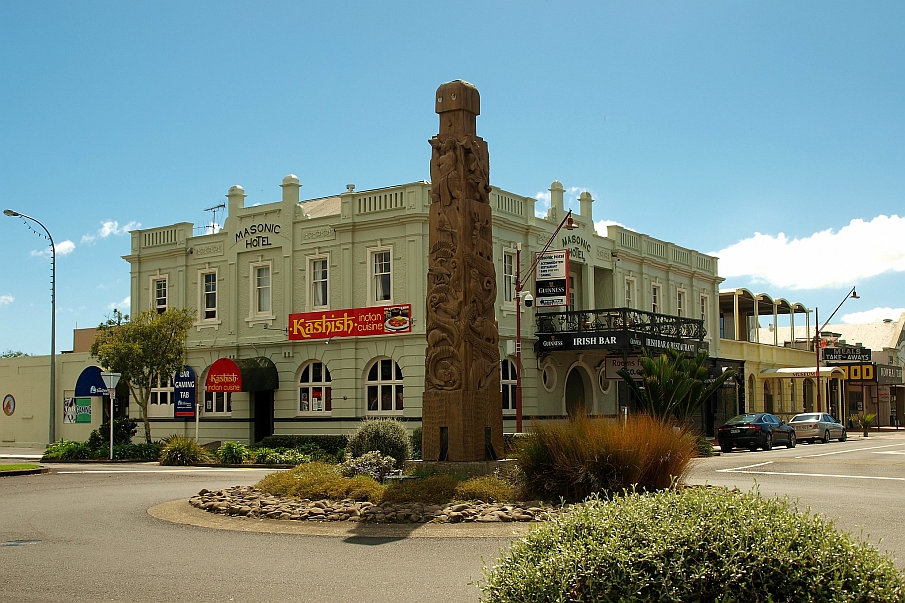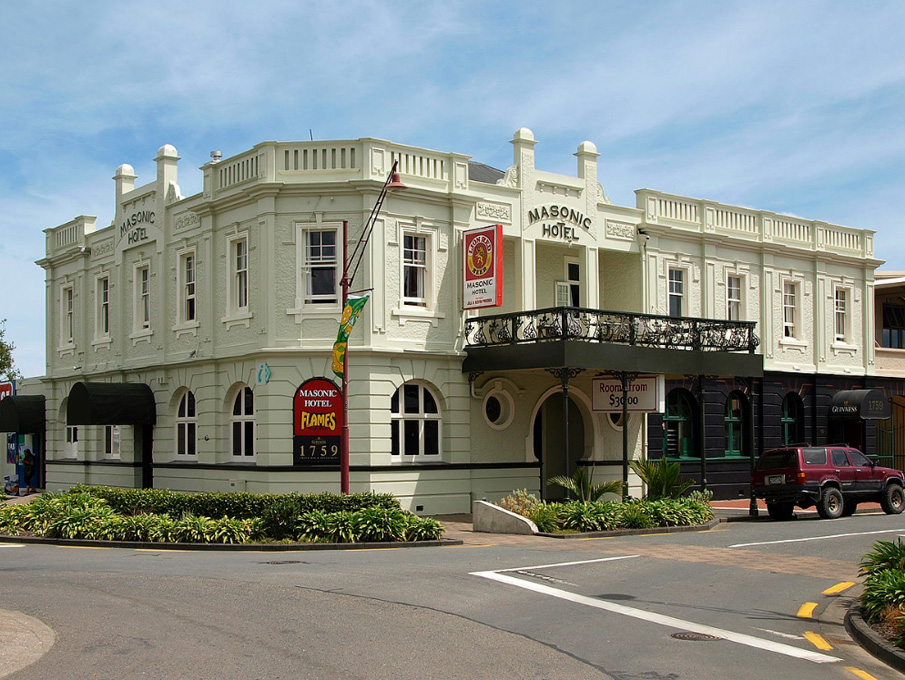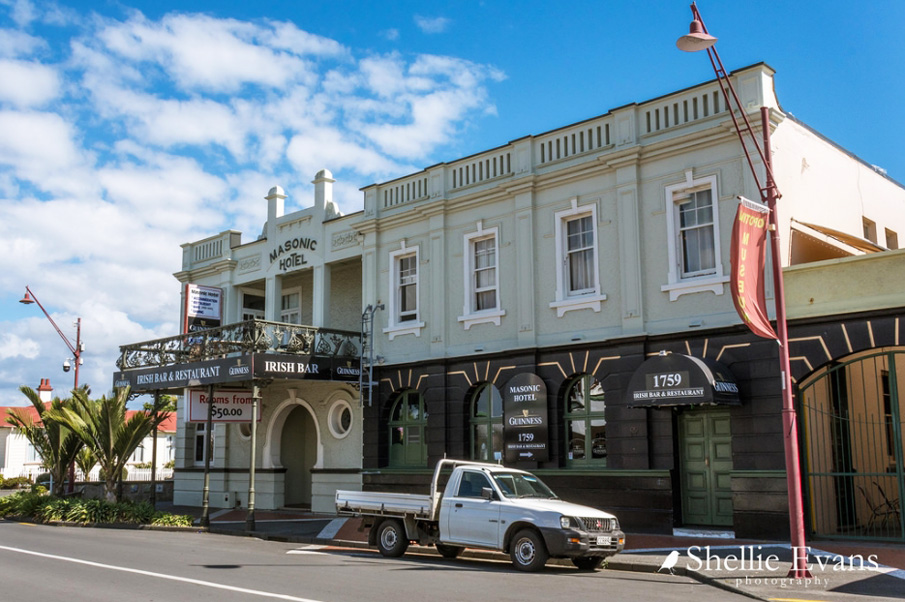The Masonic Hotel is one of several notable examples of hotel architecture in Opotiki, reflecting the town's role as a major commercial centre in the eastern Bay of Plenty. Initially constructed in the late 1860s or early 1870s, the two-storey hotel was rebuilt or largely remodelled in the second decade of the twentieth century. The first hotel was one of the earliest substantial timber structures in the colonial town, which had been laid out as a military and commercial settlement in 1866 on the site of a previous Whakatohea kainga known as Pakowhai. Erected on a prominent corner allotment, the building was positioned midway between the wharves where sea-going traffic embarked, and a military redoubt surrounding the Anglican church (see 'Hiona St Stephen's Church, Opotiki'). During the scares following Te Kooti's rebellion in the late 1860s, the first hotel is said to have accommodated officers' wives and was temporarily fortified. Some years later, it hosted a concert from the balcony by the well-known singer and composer Fanny Rose Howie (1868-1916) - also known as Princess Te Rangi Pai. By the second decade of the twentieth century, the Masonic was the only major hotel in Opotiki that had not been significantly rebuilt or altered (see also 'Royal Hotel, Opotiki', and 'Opotiki Hotel, Opotiki'). A new brick and concrete building was consequently erected in 1916 replacing much of the earlier structure. Parts of the timber hotel that were initially retained included a dining room, a kitchen and several bedrooms. These were consumed by a large fire in July 1918, after which a brick extension along Church Street was probably erected. The extension contained a new kitchen and dining facilities. An identical eclectic Edwardian Baroque style was used for both the 1916 rebuilding and its subsequent extension, although internal details differed. The architects of the rebuilt hotel are unknown but they may have been Whincup and West, whose partnership was responsible for other buildings in Opotiki with similar detailing. The design for the Masonic Hotel combined traditional architectural elements, such as a rusticated base and applied pilasters, with more modern details, including round accented windows and Art Nouveau-influenced lettering above each main door. Edwardian Baroque architecture, in general, can be seen to express respectability and solidity, while Art Nouveau features were often found on buildings linked with entertainment and relaxation. Like the nearby Royal Hotel, which was remodelled in 1908, the elaborate balconies and verandahs that had been a feature of the previous structure were removed and replaced by a front porch, which provided less encouragement for the hotel clientele to linger in public view. An image of greater respectability, as well as progressiveness, was important in the hotel trade during the 1910s, when a strong national movement seeking the prohibition of liquor existed. A place of gathering and recreation for local people, the rebuilt Masonic Hotel was described in the 1920s as 'the official house of the Government Tourist Bureau, Auckland Automobile Association, the Commercial Travellers Association, and Cook's Tours'. At this time it may have incorporated a double gateway to a large stable block. The façade of the latter still exists to the north of the main hotel building. Opotiki was on a popular tour route for early motor vehicles between Gisborne and the Bay of Plenty. The upstairs area of the hotel incorporated accommodation and a guest lounge, while the ground floor layout included a public lounge and bar, and a separate dining room. As social attitudes towards drinking began to soften in the 1960s and 1970s, the lounge was moved closer to the dining area and the bar extended. A further bar extension incorporating a casino and TAB was also added in the 1990s on the site of earlier staff quarters. The building continues to be used for accommodation, as well as the bar and restaurant trades. The Masonic Hotel is one of a valuable group of historic hotels in Opotiki, which demonstrate the changing style of provincial establishments in the early twentieth century. It has strong visual qualities, partly due to its corner location on a major commercial thoroughfare. Elements of the hotel's external and internal appearance can be linked to the effects of the prohibition movement, and later changes in attitudes to alcohol consumption. The building is linked with the history of recreation and tourism in the area. The hotel has played an important role in the social life of the community for at least 80 years, and is still in use for its original function. It is a significant part of a broader historical and archaeological landscape in Opotiki dating to the nineteenth and early twentieth centuries and lies close to other notable historic structures, such as the Courthouse, War Memorial and Hiona St Stephen's Church.



Location
List Entry Information
Overview
Detailed List Entry
Status
Listed
List Entry Status
Historic Place Category 2
Access
Able to Visit
List Number
3500
Date Entered
4th April 1984
Date of Effect
4th April 1984
City/District Council
Ōpōtiki District
Region
Bay of Plenty Region
Legal description
Lot 2 DP 3538 (RT GS5B/1062), Gisborne Land District
Related listings
Stay up to date with Heritage this month
